|
HOME: www.hiltonpond.org |
|||
THIS WEEK at HILTON POND Subscribe for free to our award-winning nature newsletter (Back to Preceding Week; on to Next Week) |
EARLY MAY 2013: In my continuing effort to catch up on posting "This Week at Hilton Pond" AND to maintain continuity in reporting phenological happenings at Hilton Pond Center, I offer the following installment covering part of the first two weeks of May 2013; along with other topics, it documents one of the Center's most diverse bird banding periods in a long time. Abbreviated versions of most entries below appeared in some form on the Center's Facebook page while others--and several images--are brand new. Happy Nature Watching! BILL HILTON JR. 5 May For the past week an unusually large (nearly 2.5") Green Treefrog, Hyla cinerea (below right), has been hanging around the back porch patio doors of the old farmhouse at Hilton Pond Center, undoubtedly gleaning insects attracted to night lights. Green Treefrogs occur from Texas to Delaware and are very common along the Carolinas coast; the species likely was introduced to the Piedmont on landscape plants from the Lowcountry. I now see Green Treefrogs annually at the Center, where they consume insects such as small crickets, flies, moths, and mosquitoes. Only in the past few years I've heard the males' distinctive evening calls--sort of like a loud but distant cowbell that's a good indication they're now breeding locally. After mating and despite her relatively small frog-size, a mature female Green Treefrog can lay up to 400 eggs in a single clutch. Depending on ambient temperatures, tadpoles hatch in 5-8 days and become froglets in about two months. (Incidentally, the Green Treefrog is the state amphibian of Louisiana and Georgia. South Carolina's is Spotted Salamander, Ambystoma maculatum.) All text, maps, charts & photos © Hilton Pond Center Today's newly banded birds at the Center are listed below, but it's worth mentioned we also recaptured quite a few "old" birds we first handled in past years. Of particular interest were two birds caught locally in December 2007: A seventh-year female American Goldfinch banded as a hatch-year bird, and an after-sixth-year female House Finch.
All text, maps, charts & photos © Hilton Pond Center 6 May We've gotten a good bit of welcome rain lately at Hilton Pond Center, particularly the past two days. On yesterday alone (up 'til midnight) the digital rain gauge showed 1.36", followed by another 0.61" through dawn before the clouds broke. That combined 1.97" rain event raised the pond level yet again; right now the float-boat at the end of the dock (see photo above) indicates Hilton Pond is merely 6" below full capacity--the first time that's happened in at least a half-dozen years. This all bodes well for fish and amphibians and other critters that like deeper water. And, as an educator-naturalist, it also makes me very happy.
All text, maps, charts & photos © Hilton Pond Center Ernesto Carman Jr. and I had planned to band nestlings in bird boxes this morning but waited until noon for the weather to warm a bit. We got to the first Carolina Chickadee nest to find the chicks had fledged just before we arrived; my guess is they had been sitting tight waiting out the rain of the past two days and jumped the nest as soon as the weather improved. So we went to the Purple Martin gourds on the dock jutting into Hilton Pond (see previous photo). We knew there was an active Eastern Bluebird nest in one gourd and were ready to band the nestlings. Whoops, they also had fledged earlier in the day. However, we DID find an adjoining gourd occupied by five chickadee nestlings that we banded and put back into their nest. They must have been about ready, too, for within 15 minutes the little bob-tailed yellow-gaped chicks were sailing into dense vegetation along the pond edge (see photo just above). There they quietly awaited post-fledging care by their parents. And speaking of Carolina Chickadees, today was a banner day for recapture of CACH banded in previous years. Most significant was a male chickadee banded on 24 August 2006 as a recent fledgling--making him now an eighth-year bird and the oldest-ever for his species at Hilton Pond Center! We also recaptured two relative whippersnapper chickadees--a fifth-year female and a third year male--plus an after-fifth-year Northern Cardinal female banded in March 2009.
All text, maps, charts & photos © Hilton Pond Center Prior to Ernesto's arrival from Costa Rica I had observed a Great Blue Heron departing Hilton Pond several times through an opening in the Hazel Alder shrubs that grow on the dam. I've never banded such a big bird, so 'Nesto and I put up a special large-mesh net designed for catching waterfowl in the hope of snaring the heron. You might know what we would capture instead would be one of the female Wood Ducks (above, with Ernesto) that are incubating eggs in one of the Center's nest boxes. The hen was a handful--actually, TWO handfuls--but 'Nesto expertly extracted her from the net and brought her back to the old farmhouse for photos. My master bird banding permit does not authorize banding of waterfowl--that privilege is extended mostly to state and federal wildlife agencies--so after examination we simply let the Wood Duck go. (She rewarded us by flying straight across the pond and right back into the net. This time we aimed her in a different direction.) Birds banded today at the Center:
All text, maps, charts & photos © Hilton Pond Center 7 May The 1,000th banded bird of 2013 at Hilton Pond Center was an afternoon adult male Black-throated Blue Warbler (above)--the fourth of this species Ernesto and I have caught the past two days. BTBW occur in late spring in the South Carolina Piedmont but virtually of them head further north; even the very few breeding records for the SC Upstate seem to be somewhat controversial.
All text, maps, charts & photos © Hilton Pond Center Yesterday we banded two female Black-throated Blue Warblers (above) whose appearance is so different from that of their mates that even John James Audubon thought they were two different species. Male and female BTBW bail out of their eastern North American breeding grounds in autumn and overwinter primarily in the Caribbean and the eastern coastal zones of Nicaragua, Costa Rica, and Panama. All text, maps, charts & photos © Hilton Pond Center Birds banded today at the Center:
All text, maps, charts & photos © Hilton Pond Center 8 May I'm not sure what else Ernesto Carman Jr. and I might catch today at Hilton Pond Center, but I'm pretty sure a subadult male Red-shouldered Hawk (above) in the net on the dam we put up to catch a Great Blue Heron would end up being our "bird of the day." It's only the 11th RSHA I've banded locally since 1982. Lots of neat stuff is visible in the photo of the hawk, but especially note the superciliary ridge that shades his eye while hunting. The eye on this bird probably would have been grayish last year when it was a recent fledgling and eventually should turn dark reddish-brown when it's a full adult. Birds banded today at the Center:
All text, maps, charts & photos © Hilton Pond Center 9 May Remember that second-year Red-shouldered Hawk Ernesto Carman and I banded yesterday at Hilton Pond Center? Well, thanks to Ernesto's keen hearing attuned to high pitched sounds, he was able to locate a RSHA nest with two chattering chicks--in a towering Southern Red Oak barely 50 feet away from the Center's old farmhouse! The nest is pretty high up even for a long lens or spotting scope, but I managed to snap a few photos (above) of one of the nestlings as it groomed itself and peered over the jumble of sticks that makes up its nursery bedroom. (Since we have an established adult pair of Red-shouldered Hawks at the Center, I doubt the immature bird we caught yesterday was a parent from the newfound nest; more likely would be that the bird we just banded was last year's sibling to this year's nestling.) Birds banded today at the Center:
All text, maps, charts & photos © Hilton Pond Center 10 May Ernesto Carman and I deployed only a few mist nets around Hilton Pond Center's old farmhouse today, but it paid off with the early morning capture of an incredibly brilliant yellow "swamp canary"--a second-year male Prothonotary Warbler. Only the 17th of this cavity-nesting species banded at the Center since 1982, I'm guessing this will be our "bird of the day" for 10 May. Note the size of the bird's bill--much heavier than the typical Wood Warbler.
All text, maps, charts & photos © Hilton Pond Center I may have jumped the gun on the Hilton Pond Center "bird of the day." A few hours after we banded the male Prothonotary Warbler a new high net Ernesto and I erected down near the pond pulled in a a second-year male Cooper's Hawk. This species breeds in the Carolina Piedmont but today's is only the third I've banded locally in 32 years. I guess folks will have to vote on today's "bird of the day": Prothonotary Warbler or Cooper's Hawk? (Postscript: A great majority of correspondents on Facebook voted for the hawk.) We didn't run our full complement of mist nets today because Ernesto and I were due to depart for Atlanta GA right after lunch. Fortunately the half dozen or so "house nets" closest to the Center's old farmhouse snared the Prothonotary Warbler and Cooper's Hawk and the sunflower seed traps captured some House Finches, so we still had some pretty good birds on the books for 10 May. Birds banded today at the Center:
All text, maps, charts & photos © Hilton Pond Center 11 May This year's International Migratory Bird Day was scheduled for 11 May to coincide with the peak of spring migration in much of the Northern Hemisphere. When Mary Kimberly of Decatur GA learned Ernesto Carman Jr. would be in the states in conjunction with this annual event, she jumped at the chance to invite 'Nesto and me to help the Atlanta Audubon Society commemorate the nature holiday. We both knew Mary well; after all, she and husband Gavin MacDonald had participated in numerous Operation RubyThroat hummingbird expeditions to the Neotropics. (And we do mean numerous. Mary and Gavin went with us to Guanacaste Province in Costa Rica in 2009, to Belize in 2010, to Guatemala in 2011, to Ujarrás in Costa Rica in 2012, and to Nicaragua in 2013.) Mary and Gavin were kind enough to entertain us at their home and to provide food and lodging. In the end we decided Ernesto would lead a morning field trip at Clyde Shepherd Nature Preserve, a 28-acre greenspace near North Dekalb Mall. It was a terrific morning for nearly three dozen participants at a surprisingly natural locale surrounded by urban sprawl.
All text, maps, charts & photos © Hilton Pond Center Following the field trip I got to chat (above) with Atlanta Audubon president Joy Carter and Charlie Seabrook, long-time environmental writer for the Atlanta Journal-Constitution newspaper. Then it was off for a picnic lunch and eventually to an early afternoon session at a local library where I offered a summary of our Ruby-throated Hummingbird research at Hilton Pond Center (30 years) and in Central America (21 expeditions since 2004). With more than 60 people in the audience the lecture also offered a chance to recruit new citizen scientists to join our upcoming trips to the Neotropics. After an early supper with Mary and Gavin, 'Nesto and I drove back toward York, stopping for a brief visit with favorite mother-in-law Norma Dressler Ballard--a long-time supporter of the Center and Operation RubyThroat. 12 May Mother's Day dawned with cloudy skies and a mere 0.01" of rain just after midnight at Hilton Pond Center, but the threat of further precipitation that never came kept us from deploying our mist nets. Bird safety is more important than bird data, and running nets in wet conditions can lead to feather matting and bird hypothermia even during relatively warm weather. Traps avoid that problem and at least allowed us to band one Northern Cardinal and a couple of House Finches and to recapture a sixth-year female HOFI banded locally as a youngster in July 2008.
All text, maps, charts & photos © Hilton Pond Center 13 May Bird migration has really slowed down at Hilton Pond Center, although we're now recapturing previously banded birds starting to forage for food for nestlings. That includes three Carolina Chickadees from the past few years whose sex we did not know until recaptured today. (Females have brood patches; males have cloacal protuberances.) Ernesto Carman and I also re-caught last week's Red-shouldered Hawk, except this time he had a headless Black Racer (snake) in his talons! The bird of the day was probably a second-year male American Redstart (see photo) that had not yet acquired his distinctive black body feathers and salmon-colored flanks and tailspots. In this species, males take two full years to gain adult plumage. Birds banded today at the Center:
14 May
The first half of May at the Center we had both diversity and good numbers of birds in nets and traps, with a satisfying 37 species and 119 individuals. The bottom fell out on the 14-15 May, however, with no birds captured either day. We can't blame it on precipitation--there was no rain--although the mercury went up to 89.2 degrees on the 15th. All contributions are tax-deductible on your |
|---|
|
"This Week at Hilton Pond" is written and photographed by Bill Hilton Jr., executive director of Hilton Pond Center for Piedmont Natural History
|
|
|
Please refer "This Week at Hilton Pond" to others by clicking on this button: |
Comments or questions about this week's installment? Send an E-mail to INFO. (Be sure to scroll down for a tally of birds banded/recaptured during the period, plus other nature notes.) |


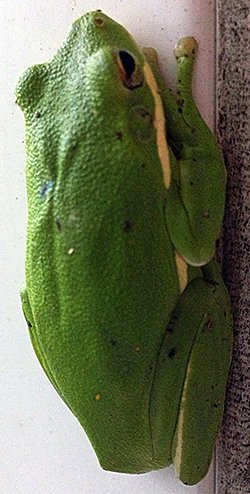 It clings to window glass and other objects with its large circular toe pads. Although this frog's body is normally bright lime green with a distinctive lateral yellow or white stripe, in cool weather the base color is almost brown. Its dorsum is o
It clings to window glass and other objects with its large circular toe pads. Although this frog's body is normally bright lime green with a distinctive lateral yellow or white stripe, in cool weather the base color is almost brown. Its dorsum is o
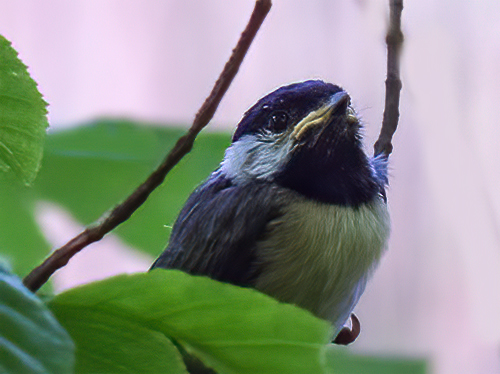
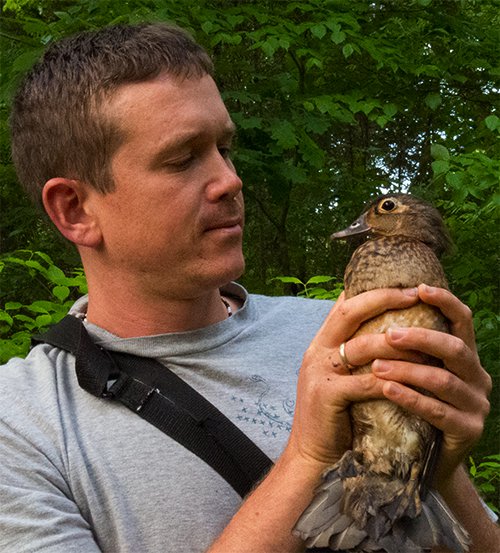
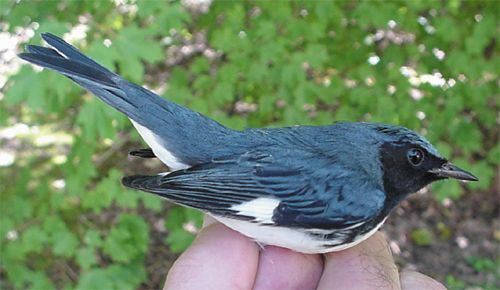
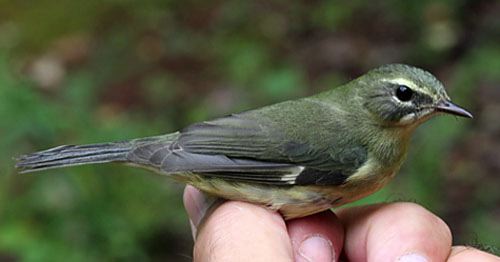

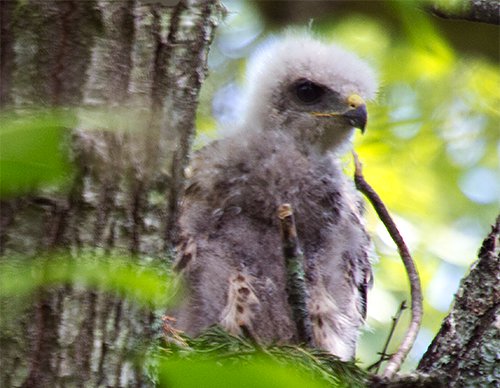
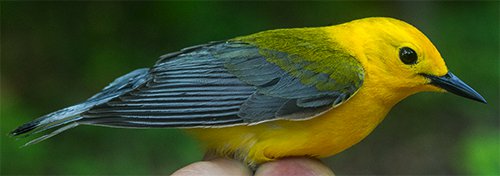
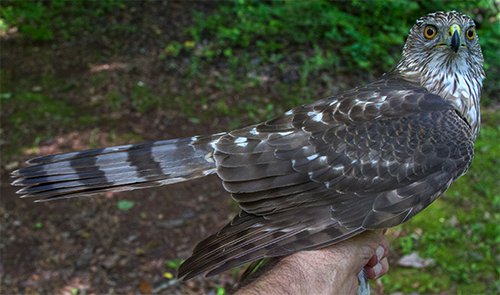
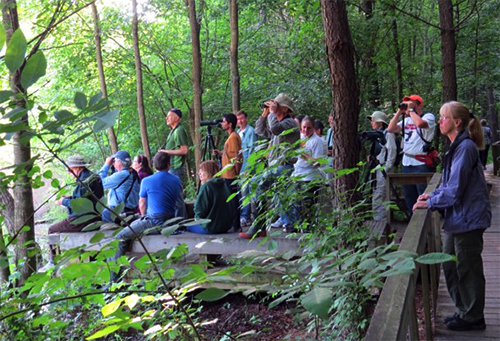
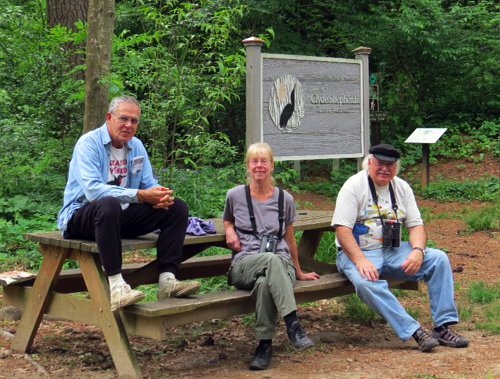
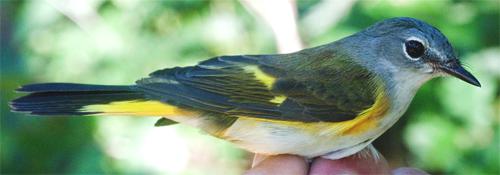








 Please report your sightings of
Please report your sightings of